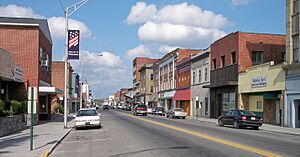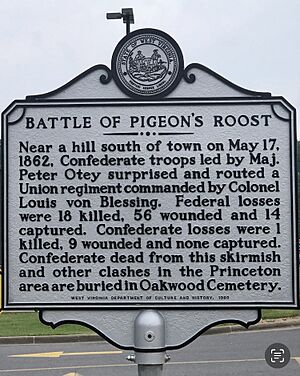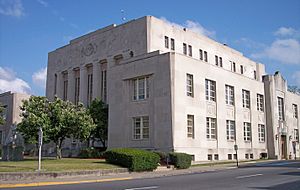Princeton, West Virginia facts for kids
Quick facts for kids
Princeton, West Virginia
|
||
|---|---|---|

Downtown Princeton
|
||
|
||
| Nickname(s):
The Heart of Mercer County
|
||

Location of Princeton in Mercer County, West Virginia
|
||
| Country | United States | |
| State | West Virginia | |
| County | Mercer | |
| Area | ||
| • Total | 3.05 sq mi (7.91 km2) | |
| • Land | 3.01 sq mi (7.81 km2) | |
| • Water | 0.04 sq mi (0.10 km2) | |
| Elevation | 2,431 ft (741 m) | |
| Population
(2020)
|
||
| • Total | 5,872 | |
| • Density | 1,925/sq mi (742.4/km2) | |
| Time zone | UTC-5 (Eastern (EST)) | |
| • Summer (DST) | UTC-4 (EDT) | |
| ZIP code |
24739 & 24740
|
|
| Area code(s) | 304 | |
| FIPS code | 54-65692 | |
| GNIS feature ID | 2390640 | |
Princeton is a city in Mercer County, West Virginia, United States. It is the county seat, which means it's where the main government offices for the county are located. In 2020, about 5,872 people lived here. Princeton is also home to the Princeton WhistlePigs, a baseball team in the Appalachian League.
Contents
Princeton's Past: A Look at Its History
How Princeton Got Its Name
Princeton was named after the Battle of Princeton in Princeton, New Jersey. A general named Hugh Mercer died in that battle. Mercer County, where Princeton is located, was named after him. In 1837, when Mercer County was created, William Smith gave 1.5 acres of land for the county courthouse. This land became the city of Princeton.
Princeton During the Civil War
While no huge battles happened right in Princeton, there was a fight nearby on May 17, 1862. It was called the Battle of Pigeon Roost or the Battle of Princeton Courthouse. Confederate soldiers won this battle, protecting a railroad.
A few weeks before the battle, on May 1, Princeton was burned. Confederate soldiers burned the town to stop the Union army from getting their supplies. Many residents even burned their own homes and left. Only a few buildings remained. The Robert McNutt house is the only original building left. It was even used by the Union army for a time.
Princeton and Mercer County supported the Confederacy. They were not part of the new state of West Virginia when it was first formed. After the war, Princeton slowly rebuilt. The arrival of the railroad later brought a lot of growth to the city.
The Rise of the Coal Industry
In the late 1800s, coal mining became very important in Southern West Virginia. Railroads helped transport the coal. This new industry changed the region. Coal was sent to the Great Lakes, Baltimore, and Hampton Roads in Virginia.
Princeton was not in the main coal mining areas at first. But soon, things changed. The coal industry and railroads had a big impact on Princeton's money and growth.
Building New Railroads
In 1896, an engineer named William Nelson Page started a small logging railroad. It was called the Loup Creek and Deepwater Railway. Later, in 1898, it became the Deepwater Railway. Page wanted to expand it to reach coal mines.
Around 1903, the town of Page became an early stop on this growing railway. William Page then got help from a rich businessman, Henry H. Rogers, in 1902. Rogers secretly helped pay for the Deepwater Railway to expand much further. They planned to build about 80 miles of track to reach new areas with lots of coal.
The leaders of bigger railroads tried to stop Page. They didn't want new railroads competing with them. They thought Page would give up because building railroads was very expensive. But Page and Rogers kept going. They even planned to build the railway all the way to the Virginia state line. This expansion brought the Deepwater Railway through Mercer County and Princeton.
The Tidewater Railway Story
In Virginia, Page and Rogers started another railroad called the Tidewater Railway. This new railway secretly bought land for its tracks across southern Virginia. It ran almost parallel to the Norfolk and Western Railway (N&W). They even got land in Roanoke, where the N&W had its main offices.
The Tidewater Railway then built a route around the city of Norfolk. It ended at a new coal pier on the harbor at Hampton Roads. By the time the big railroad leaders realized what was happening, it was too late. The new railway could not be stopped. In 1906, the N&W president met Henry Huttleston Rogers. That's when they finally learned who was funding William Nelson Page's big plans.
The Virginian Railway's Journey
In 1907, the Deepwater and Tidewater railways joined together. They became the Virginian Railway (VGN). A new town, Victoria, became the main office for the eastern part of the railway. The VGN was built using modern methods and Rogers' money. It was considered an amazing engineering project when it was finished in 1909. It stretched about 360 miles from Deepwater to a port near Norfolk, Virginia.
Princeton became the headquarters for the New River Division of the VGN. This division covered the railway from Roanoke westward.
Changes and Decline
Over time, trains changed from steam to diesel-electric engines. Also, railroads merged, and coal mining slowed down in West Virginia. This meant many jobs at the VGN in Princeton were lost. By the late 1900s, almost all these jobs were gone.
Most of the old VGN Princeton Shops buildings were torn down by 2006. This was a sad time for the people of Princeton. However, a new building was built that looks just like the original VGN Princeton Passenger Station. This new building is a museum that celebrates the town's rich railroad history and the Virginian Railway.
Princeton's Location and Weather
Where is Princeton Located?
Princeton covers about 3.05 square miles. Most of this area is land, with a small amount of water. The city is about 2,400 feet above sea level. Some parts are as high as 3,100 feet, and others are as low as 1,700 feet.
What's the Weather Like in Princeton?
| Climate data for Princeton, West Virginia | |||||||||||||
|---|---|---|---|---|---|---|---|---|---|---|---|---|---|
| Month | Jan | Feb | Mar | Apr | May | Jun | Jul | Aug | Sep | Oct | Nov | Dec | Year |
| Record high °F (°C) | 72 (22) |
75 (24) |
83 (28) |
88 (31) |
89 (32) |
97 (36) |
96 (36) |
95 (35) |
93 (34) |
88 (31) |
81 (27) |
74 (23) |
97 (36) |
| Mean daily maximum °F (°C) | 42 (6) |
46 (8) |
54 (12) |
65 (18) |
72 (22) |
79 (26) |
81 (27) |
81 (27) |
75 (24) |
66 (19) |
56 (13) |
45 (7) |
64 (17) |
| Mean daily minimum °F (°C) | 26 (−3) |
29 (−2) |
36 (2) |
45 (7) |
53 (12) |
61 (16) |
65 (18) |
64 (18) |
57 (14) |
47 (8) |
39 (4) |
30 (−1) |
46 (8) |
| Record low °F (°C) | −21 (−29) |
−9 (−23) |
−2 (−19) |
15 (−9) |
24 (−4) |
37 (3) |
40 (4) |
39 (4) |
30 (−1) |
18 (−8) |
7 (−14) |
−13 (−25) |
−21 (−29) |
| Source: The Weather Channel | |||||||||||||
Who Lives in Princeton? (Demographics)
| Historical population | |||
|---|---|---|---|
| Census | Pop. | %± | |
| 1890 | 320 | — | |
| 1910 | 3,027 | — | |
| 1920 | 6,224 | 105.6% | |
| 1930 | 6,955 | 11.7% | |
| 1940 | 7,426 | 6.8% | |
| 1950 | 8,279 | 11.5% | |
| 1960 | 8,393 | 1.4% | |
| 1970 | 7,253 | −13.6% | |
| 1980 | 7,538 | 3.9% | |
| 1990 | 7,043 | −6.6% | |
| 2000 | 6,347 | −9.9% | |
| 2010 | 6,432 | 1.3% | |
| 2020 | 5,872 | −8.7% | |
| U.S. Decennial Census 2020 | |||
Princeton's Population in 2010
In 2010, Princeton had 6,432 people living there. There were 3,030 households. Most people (90.7%) were White. About 6.3% were African American. Other groups included Native American, Asian, and people of two or more races. About 1.1% of the population was Hispanic or Latino.
The average age in Princeton was 42.6 years old. About 19.4% of residents were under 18.
Learning in Princeton: Education
All students in Princeton attend schools in the Mercer County School District.
Princeton's Culture and Attractions
What to See and Do in Princeton
Princeton has a lively cultural scene. The Chuck Mathena Center, opened in 2008, has a large theater for shows and meeting rooms. You can also visit the RiffRaff Arts Collective, the Princeton Public Library, and the Railroad Museum.
Several important buildings in Princeton are listed on the National Register of Historic Places. These include the Dr. James W. Hale House, the Dr. Robert B. McNutt House, and the Mercer County Courthouse. The Mercer Street Historic District and Virginian Railway Yard Historic District are also recognized for their historical importance.
Sports in Princeton
Princeton has a Minor League Baseball team called the Princeton WhistlePigs. They play their home games at H. P. Hunnicutt Field. The team is part of a college summer baseball league for younger players.
Princeton's Twin Town
Princeton has a special connection with another city far away. It is a twin town with Yoshkar-Ola, Russia.
Famous People from Princeton
Many notable people have come from Princeton, including:
- Rod Thorn, a Hall of Fame basketball player and executive.
- Lee Patton, a legendary Hall of Fame coach.
- William Eskridge, an American legal scholar.
- Joseph Shrader, a retired United States Marine Corps major general.
See also
 In Spanish: Princeton (Virginia Occidental) para niños
In Spanish: Princeton (Virginia Occidental) para niños




